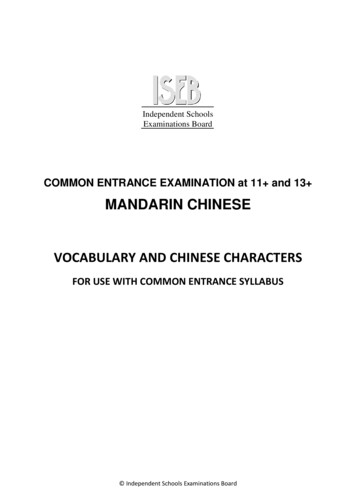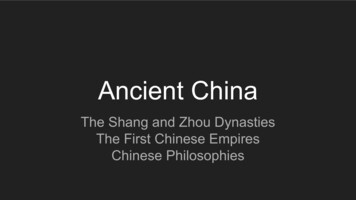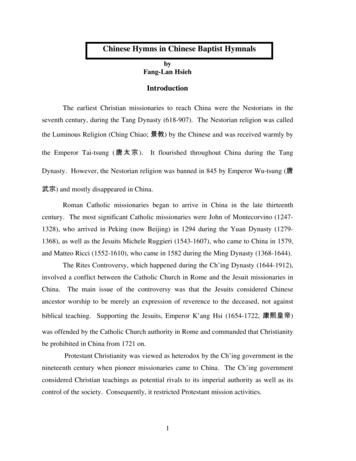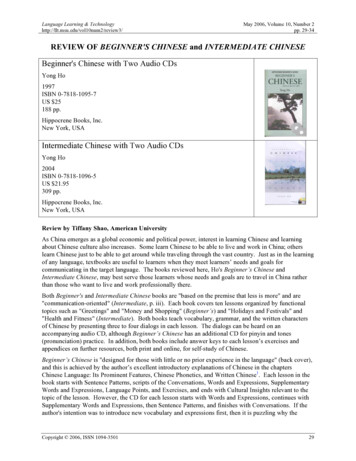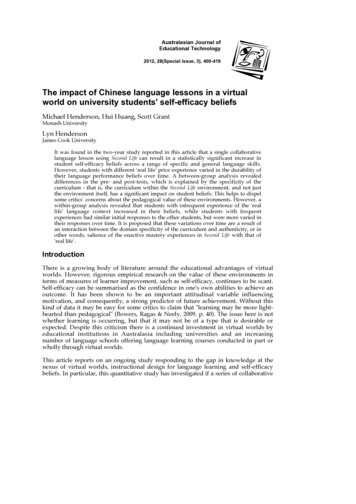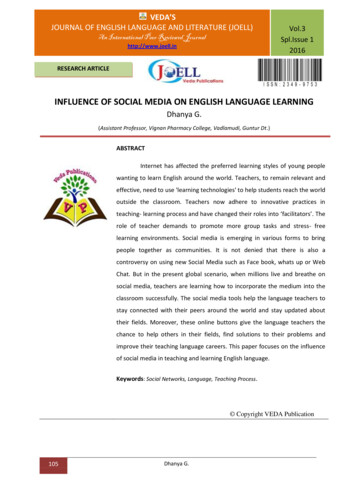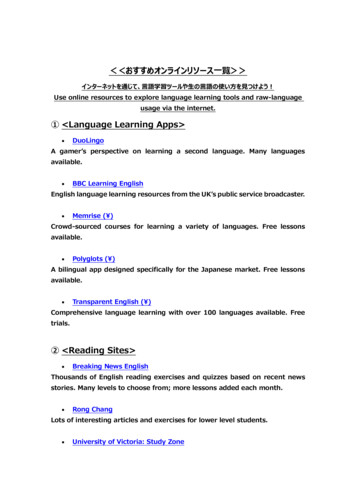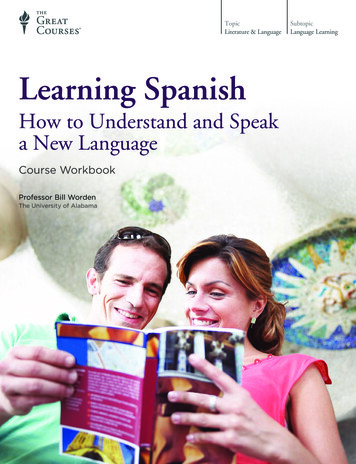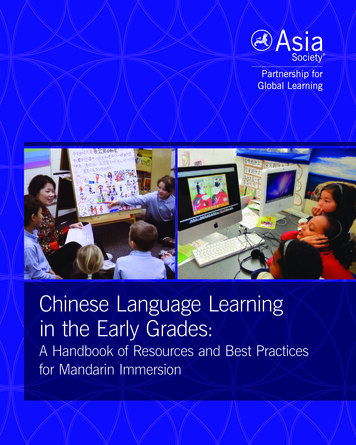
Transcription
Chinese Language Learningin the Early Grades:A Handbook of Resources and Best Practicesfor Mandarin Immersion
Asia Society is the leading global and pan-Asian organization workingto strengthen relationships and promote understanding among thepeoples, leaders, and institutions of Asia and the United States. Weseek to increase knowledge and enhance dialogue, encourage creativeexpression, and generate new ideas across the fields of policy, business,education, arts, and culture. The Asia Society Partnership for GlobalLearning develops youth to be globally competent citizens, workers, andleaders by equipping them with the knowledge and skills needed forsuccess in an increasingly interconnected world.AsiaSociety.org/Chinese Copyright 2012 by the Asia Society.ISBN 978-1-936123-28-5
Table of Contents3 PrefacePROGRAM PROFILE:34 The Utah Dual Language Immersion ProgramBy Vivien Stewart5 Introduction36By Myriam MetBy Myriam Met7 Editors’ Note and List of ContributorsPROGRAM PROFILE:40 Washington Yu Ying Public Charter School9 What the Research Says About Immersion14162224Curriculum and LiteracyBy Tara Williams Fortune42 Student Assessment and Program EvaluationPROGRAM PROFILE: By Ann Tollefson, with Michael Bacon, Kyle Ennis,Carl Falsgraf, and Nancy RhodesMinnesota’s Chinese Immersion ModelPROGRAM PROFILE:Basics of Program DesignBy Myriam Met and Chris Livaccari46 Global Village Charter Collaborative,ColoradoPROGRAM PROFILE:48 Marketing and AdvocacyPortland, Oregon Public SchoolsBy Christina Burton HoweStaffing and Professional DevelopmentPROGRAM PROFILE:54 Pioneer Valley Chinese Immersion CharterSchool, MassachusettsBy Jeff Bissell and Kevin ChangPROGRAM PROFILE:28 Chinese American International School,California56 Classroom Materials and Other Resources30 Instructional Strategies: SuccessfulApproaches to Immersion Teaching58 Key Information ResourcesBy Yu-Lan LinBy Robin HarveyBy Chris Livaccari1
PREFACEWhy Language Immersion? Why Now?and Arabic, which tend to take longer for students tomaster than European languages.Moreover, early language learning has cognitive andacademic benefits beyond facility with languages. Theseadvantages include increased mental flexibility, improveddivergent thinking, and, some studies show, higherscores on measures of verbal ability in the subject’s nativelanguage. As anyone who has learned another languageknows, it also enhances a student’s understanding of thestructure and patterns of English.Beyond the language skills acquired, learning a language gives tremendous insight into other cultures.Today’s world language instruction goes well beyondrehearsing verb tenses to teaching students about theart, literature, music, history, and everyday life of othercountries. In learning about other countries or regions,students come to understand that different languages andcultures use different strategies of communication andthey learn to see issues from multiple perspectives. Theyalso develop a set of skills that enable them to adapt (codeswitch) between different cultural communication strategies, a skill that is useful in our diverse communities aswell as internationally. Learning a second language cantherefore benefit students even if they do not attain highlevels of proficiency.Polls show that parents are becoming aware of theimportance of early language learning. But unlike otherindustrial countries, where learning languages is a corepart of the curriculum and instruction starts in earlyelementary school, the United States does not yet offerwidespread opportunities to learn languages in primaryschool. Learning opportunities vary in type, rangingfrom short awareness courses, to a foreign language asa distinct subject three times a week, to immersion pro-By Vivien StewartYoung Americans growing up in this interconnected world need knowledge and skills that aresignificantly different from those valued by previous generations. A key priority is the ability to communicate in other languages and across cultures. In today’sglobalized economy, where much economic growth isincreasingly outside the United States, there is a growing need for workers with knowledge of foreign languagesand cultures to market products to customers around theworld and to work effectively with foreign employees andpartners in other countries. Our most pressing challengesalso know no boundaries and will only be solved throughinternational cooperation among civil society groups aswell as governments. We need to give our students theknowledge and tools to act effectively as citizens in thisinterconnected world of the future.Although it is certainly possible to learn a languagelater in life, studies show that there is a significant advantage for those who have the opportunity to studyearly. Research on cognition demonstrates that thehuman brain is more open to linguistic developmentin the years before adolescence, so children who learna language early are more likely to achieve native-likepronunciation. Evidence also suggests that an earlyeducation in one language makes it easier for studentsto learn another language later in life. And when students start learning a language in elementary school andcontinue over several years, they can more easily achievehigh levels of fluency than students who do not start asecond language until high school. This is particularlyimportant for the increasingly significant yet traditionally less-frequently taught languages such as Chinese3
grams in which elementary students spend part or all ofthe day learning the academic curriculum in a secondlanguage. Immersion programs can be either full immersion (all subjects taught in the second language) orpartial immersion (part of the curriculum taught in thesecond language) or two-way, dual immersion, wherehalf the students are native speakers of a non-anglophone language and half have English as their primarylanguage. Study after study has shown that children inthese immersion programs can reach far higher levelsof language proficiency than those in other programswhile showing no decrease in their achievement scores inother subjects, even when the assessment is in English.Immersion programs are common in some other countries, such as in Canada for example, but are relativelyrare in the United States.Building on the encouraging research and growingpublic interest in early language learning, this handbookaddresses the key issues communities need to considerin establishing and sustaining effective early languageprograms. The handbook draws from research on critical features of program design and the experiences ofpioneering programs that are at the forefront of languagelearning. We hope it will contribute to more opportunities for students in their early years to learn languages,particularly Chinese, a language we as a nation can nolonger afford to ignore.4
INTRODUCTIONChinese Language Immersion:The State of the Fieldsame issues that now face their newer counterparts, exploringsolutions to common questions such as the following:By Myriam MetOver the last four decades, immersion programs inmany languages have seen slow but steady growthin US schools. Research shows that immersion isan especially effective method for language acquisition.Immersion students gain proficiency in a new languagewithout any detriment to progress in their native languageor to subject matter achievement.Chinese immersion programs are among the fastestgrowing areas of language education in American schools.Immersion programs are increasingly popular becausethey result in high levels of proficiency at relatively lowcost. Since immersion programs usually start in kindergarten or first grade, they provide ample time within astudent’s academic career for the development of oral andwritten proficiency in Chinese.In previous decades, most immersion programs have offered European languages, with a small number in other languages. Much of what is known about immersion’s effectiveness has been gleaned from these programs. Their experiencesprovide useful guidance about options for program models,teaching strategies, literacy development, and time allocationfor both the immersion language and English. While weknow a great deal about what works in immersion and why,we are still discovering which aspects of this kind of education can be appropriately applied to Chinese instruction.A handful of US programs in Mandarin and Cantoneserepresent the pioneers in Chinese immersion. Prior to 2000,there were fewer than ten public or private elementary schoolimmersion programs in either Cantonese or Mandarin. Thesepioneer programs led the way for the approximately seventynew programs now operating, most of which are still in theirinfancy. These more-established programs have addressed the Which type of program model is most suited to Chineseimmersion: Most or all of the school day taught inMandarin, a fifty-fifty division between Chinese andEnglish, or some other distribution of time? What are the qualifications for teaching in Chinese immersion? Where can we find highly qualified teachers? Whatdoes high-quality Chinese immersion instruction look like? What curricula and instructional materials are alreadyavailable for Chinese immersion? How might we approach literacy development in Chinese?To their credit, the teachers and administrators who haveworked in the small number of long-standing Chinese immersion programs generously share their experiences, expertise, and material resources with one another as well aswith the newly emerging programs around the country. Theyanswer numerous inquiries made by email or phone, theycheerfully host visitors, and they network with one anotherand collaborate on important projects.One of those projects is this handbook. In the pages thatfollow readers will find the accumulated expertise of veteranChinese immersion program administrators and teachers.Over time, our understanding of what makes Chinese immersion programs successful will continue to change, justas our thinking about education in general continuouslyevolves. Thus, while this handbook represents the best ofwhat we currently know about Chinese immersion, it represents only one step in a longer journey.5
Editors’ Noteand List of ContributorsThis handbook was a collaborative effort made possible by thecontributions of practitionersof Chinese language immersionin the elementary grades. As theirprograms continue to expand, it isincreasingly important for them toshare resources, best practices, andsuccessful strategies.Despite the challenges of thisrelatively new model of languageteaching in the US, the benefits ofhigh-quality immersion programsare sufficiently great that their numbers are growing across the country.In the pages that follow, you willlearn about some of the most successful Chinese language immersionprograms in the US. You will alsolearn about the realities of programsthat require a high level of commitment among teachers, parents, andadministrators. The resources andmodels in this handbook are meantto help you anticipate the questionsyou will need to answer as you consider building your program.Martha AbbottMichael BaconJeff BissellKevin ChangNorman CaoMarty ChenAiping DongKyle EnnisCarl FalsgrafTara Williams FortuneYiling HanRobin HarveyChristina Burton HoweHsiuwen HsiehEleise JonesYu-Lan LinNa LiuChris LivaccariMyriam MetMary PattersonNancy RhodesGregg RobertsYin ShenVivien StewartSandy TalbotAnn TollefsonJeff WangKathleen WangLijing YangPearl YouYi Zheng7 merican Council on the Teaching of Foreign LanguagesAPortland Public Schools Chinese American International School Chinese American International School Global Village Charter CollaborativeUtah State Office of Education Pioneer Valley Chinese Immersion Charter SchoolAvant Assessment Center for Applied Second Language Studies Center for Advanced Research on Language AcquisitionGlobal Village Charter CollaborativeNew York University Global Village Charter Collaborative Pioneer Valley Chinese Immersion Charter SchoolAsia SocietyBoston Public SchoolsCenter for Applied LinguisticsAsia SocietyIndependent ConsultantPortland Public SchoolsCenter for Applied LinguisticsUtah State Office of EducationPortland Public SchoolsAsia SocietyUtah State Office of EducationIndependent ConsultantAsia Society Pioneer Valley Chinese Immersion Charter School Washington Yu Ying Public Charter School Washington Yu Ying Public Charter SchoolAsia Society
What the Research Says About ImmersionThis finding applies to students from a range of socioeconomic and ethnic backgrounds,2 as well as diversecognitive and linguistic abilities.3 Moreover, academicachievement on tests administered in English occurs regardless of the second language being learned. In otherwords, whether learning through alphabetic languages(Spanish, Hawaiian, French, etc.) or character-basedlanguages (Mandarin, Japanese, Cantonese), Englishproficient students will keep pace academically with peersin English-medium programs.4It is important to acknowledge that early studies carriedout in one-way total immersion programs, where Englishmay not be introduced until grades 2–5, show evidenceof a temporary lag in specific English language skills suchas spelling, capitalization, punctuation, word knowledge,By Tara Williams FortuneOver nearly half a century, research on languageimmersion education has heralded benefits suchas academic achievement, language and literacydevelopment in two or more languages, and cognitiveskills. This research also exposes some of the challengesthat accompany the immersion model, with its multilayered agenda of language, literacy and intercultural skillsdevelopment during subject matter learning. This chapteroutlines key findings for both advantages and challenges.Benefits of Language ImmersionAcademic and EducationalWithout question, the issue investigated most often inresearch on language immersion education is students’ability to perform academically on s
Chinese immersion program administrators and teachers. Over time, our understanding of what makes Chinese im-mersion programs successful will continue to change, just as our thinking about education in general continuously evolves. Thus, while this handbook represents the best of what we currently know about Chinese immersion, it repre- sents only one step in a longer journey.
